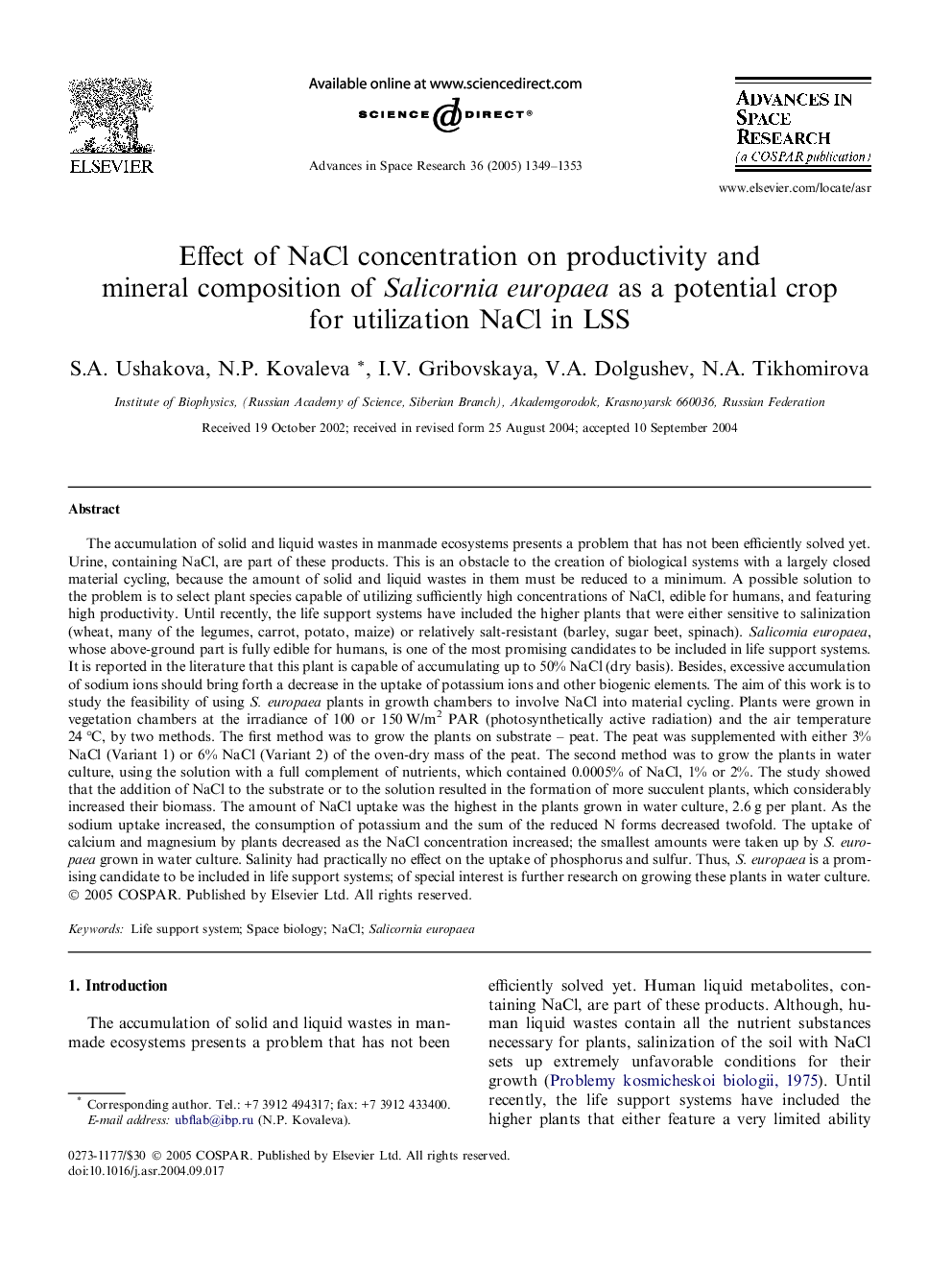| کد مقاله | کد نشریه | سال انتشار | مقاله انگلیسی | نسخه تمام متن |
|---|---|---|---|---|
| 10694708 | 1020239 | 2005 | 5 صفحه PDF | دانلود رایگان |
عنوان انگلیسی مقاله ISI
Effect of NaCl concentration on productivity and mineral composition of Salicornia europaea as a potential crop for utilization NaCl in LSS
دانلود مقاله + سفارش ترجمه
دانلود مقاله ISI انگلیسی
رایگان برای ایرانیان
کلمات کلیدی
موضوعات مرتبط
مهندسی و علوم پایه
علوم زمین و سیارات
علوم فضا و نجوم
پیش نمایش صفحه اول مقاله

چکیده انگلیسی
The accumulation of solid and liquid wastes in manmade ecosystems presents a problem that has not been efficiently solved yet. Urine, containing NaCl, are part of these products. This is an obstacle to the creation of biological systems with a largely closed material cycling, because the amount of solid and liquid wastes in them must be reduced to a minimum. A possible solution to the problem is to select plant species capable of utilizing sufficiently high concentrations of NaCl, edible for humans, and featuring high productivity. Until recently, the life support systems have included the higher plants that were either sensitive to salinization (wheat, many of the legumes, carrot, potato, maize) or relatively salt-resistant (barley, sugar beet, spinach). Salicomia europaea, whose above-ground part is fully edible for humans, is one of the most promising candidates to be included in life support systems. It is reported in the literature that this plant is capable of accumulating up to 50% NaCl (dry basis). Besides, excessive accumulation of sodium ions should bring forth a decrease in the uptake of potassium ions and other biogenic elements. The aim of this work is to study the feasibility of using S. europaea plants in growth chambers to involve NaCl into material cycling. Plants were grown in vegetation chambers at the irradiance of 100 or 150 W/m2 PAR (photosynthetically active radiation) and the air temperature 24 °C, by two methods. The first method was to grow the plants on substrate - peat. The peat was supplemented with either 3% NaCl (Variant 1) or 6% NaCl (Variant 2) of the oven-dry mass of the peat. The second method was to grow the plants in water culture, using the solution with a full complement of nutrients, which contained 0.0005% of NaCl, 1% or 2%. The study showed that the addition of NaCl to the substrate or to the solution resulted in the formation of more succulent plants, which considerably increased their biomass. The amount of NaCl uptake was the highest in the plants grown in water culture, 2.6 g per plant. As the sodium uptake increased, the consumption of potassium and the sum of the reduced N forms decreased twofold. The uptake of calcium and magnesium by plants decreased as the NaCl concentration increased; the smallest amounts were taken up by S. europaea grown in water culture. Salinity had practically no effect on the uptake of phosphorus and sulfur. Thus, S. europaea is a promising candidate to be included in life support systems; of special interest is further research on growing these plants in water culture.
ناشر
Database: Elsevier - ScienceDirect (ساینس دایرکت)
Journal: Advances in Space Research - Volume 36, Issue 7, 2005, Pages 1349-1353
Journal: Advances in Space Research - Volume 36, Issue 7, 2005, Pages 1349-1353
نویسندگان
S.A. Ushakova, N.P. Kovaleva, I.V. Gribovskaya, V.A. Dolgushev, N.A. Tikhomirova,